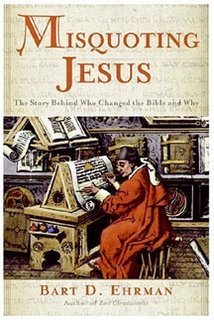1. Synopsis
 Introduction (pp. 1-15). Ehrman explains why the subject of the text of the New Testament is one that has radically affected him both emotionally and intellectually. He was brought up in a ‘churchgoing but not particularly religious’ family (p. 1) but in teenage years felt a kind of loneliness (which he now thinks was just what all teenagers feel). After becoming involved in a Campus Life Youth for Christ club he had a ‘born-again’ experience aged 15 and some time after that was encouraged to attend the Moody Bible Institute in Chicago, which he did in 1973. This institution held to biblical inerrancy and that the words of the autograph were inspired, but in an early class he encountered the fact that we do not possess the autographs, only ‘error-ridden copies of the autographs’ (p. 5). This got him interested in trying to learn about textual criticism. By the end of his three-year diploma at Moody he wanted to become ‘... an evangelical “voice” in secular circles, by getting degrees that would allow me to teach in secular settings while retaining my evangelical commitments’ (pp. 5-6). He went to Wheaton College, majoring in English and learning Greek, and there he experienced some doubts. After two years he went to Princeton Theological Seminary, where he studied with Bruce Metzger. He writes, ‘A turning point came in my second semester’ (p. 8), during a course on Mark when he had written a paper trying to justify the name ‘Abiathar’ in Mark 2:26 and his professor, Cullen Story, wrote thereon ‘Maybe Mark just made a mistake’. Once Ehrman had concluded that he did, ‘the floodgates opened’ to admitting other problems in scripture (p. 9) and then to having a radical rethink of his understanding of the Bible. He now writes a book which he believes is the first of its kind: a book ‘for people who know nothing about textual criticism’ (p. 15).
Introduction (pp. 1-15). Ehrman explains why the subject of the text of the New Testament is one that has radically affected him both emotionally and intellectually. He was brought up in a ‘churchgoing but not particularly religious’ family (p. 1) but in teenage years felt a kind of loneliness (which he now thinks was just what all teenagers feel). After becoming involved in a Campus Life Youth for Christ club he had a ‘born-again’ experience aged 15 and some time after that was encouraged to attend the Moody Bible Institute in Chicago, which he did in 1973. This institution held to biblical inerrancy and that the words of the autograph were inspired, but in an early class he encountered the fact that we do not possess the autographs, only ‘error-ridden copies of the autographs’ (p. 5). This got him interested in trying to learn about textual criticism. By the end of his three-year diploma at Moody he wanted to become ‘... an evangelical “voice” in secular circles, by getting degrees that would allow me to teach in secular settings while retaining my evangelical commitments’ (pp. 5-6). He went to Wheaton College, majoring in English and learning Greek, and there he experienced some doubts. After two years he went to Princeton Theological Seminary, where he studied with Bruce Metzger. He writes, ‘A turning point came in my second semester’ (p. 8), during a course on Mark when he had written a paper trying to justify the name ‘Abiathar’ in Mark 2:26 and his professor, Cullen Story, wrote thereon ‘Maybe Mark just made a mistake’. Once Ehrman had concluded that he did, ‘the floodgates opened’ to admitting other problems in scripture (p. 9) and then to having a radical rethink of his understanding of the Bible. He now writes a book which he believes is the first of its kind: a book ‘for people who know nothing about textual criticism’ (p. 15).1. The Beginnings of Christian Scripture (pp. 17-43). Judaism was a religion of the book and writing became important within Christian churches through such things as Paul’s letters, pseudonymous letters, early gospels, acts, apocalypses, church orders, apologies, martyrologies, antiheretical tractates and early Christian commentaries. A canon began to form and people began to ascribe to New Testament writings the authority already ascribed to the Old Testament. In response to Marcion, the ‘Orthodox’ sought to delineate the canon’s boundaries. Despite the importance of writings for the churches, literacy was not common and there was consequently an emphasis on reading texts out publicly.